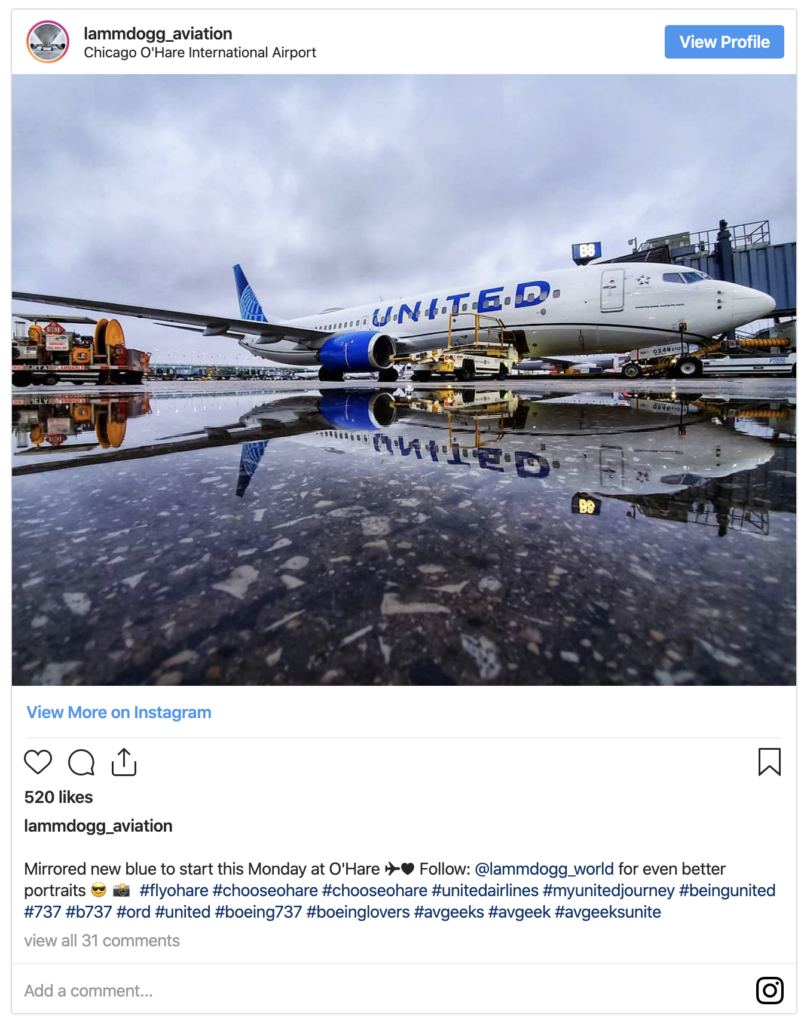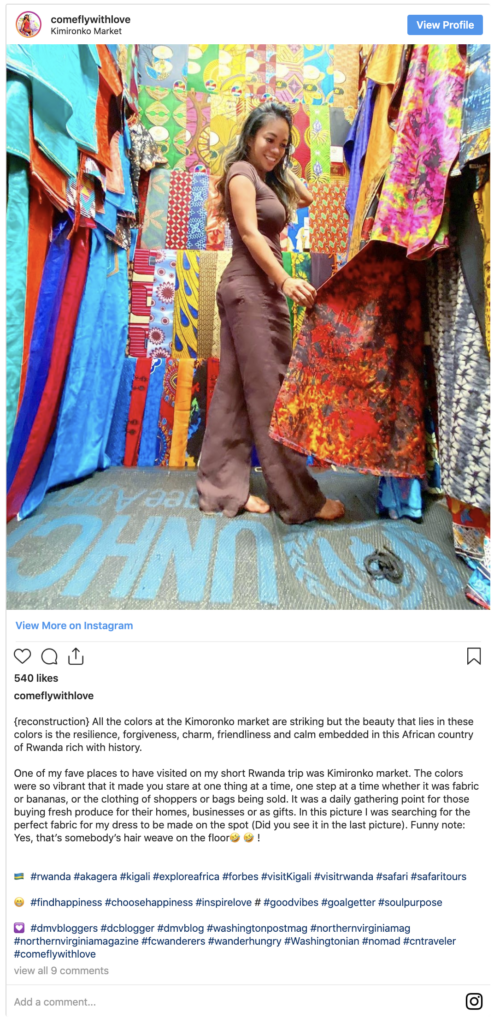Companies Tap Employees To Spread More ‘Authentic’ Messages Online
This article was written by Lauren Zumbach for The Chicago Tribune and originally published on Friday 17th January 2020. US readers can access the original article.

United baggage handler and in-house photographer Joe Lammerman works on the ramp at O’Hare International Airport on Jan. 15, 2020, in Chicago. (E. Jason Wambsgans / Chicago Tribune)
When United Airlines baggage handler Joe Lammerman started sharing behind-the-scenes photos taken during quiet moments on the job on social media, the airline didn’t tell him to put the camera down and get back to work.
Instead, it made it part of his job. For the past couple of years, Lammerman, who is based in Chicago, said he’s gone from handling bags to serving as a company photographer. He’s also part of a new group of employees United treats as an in- house team of social media influencers.
Most major companies already have a presence on social media. Many partner with professional influencers hired for their audience. But some are now trying to add their own employees to the mix, whether they’re trying to attract customers, recruit new hires or just boost a brand’s image.

Photo Courtesy of @Iammdogg_aviation
Employees typically have a fraction of the followers a top celebrity influencer would draw. But their posts can feel more authentic than those from an official company account. That authenticity requires companies to give up some control, a potentially nerve-wracking step when a viral misstep can land a company in hot water, fast.
It’s still a relatively new strategy. Companies are used to relying on official marketing and communications teams to build their brand, and most employees think of social networks like Instagram, Facebook and Snapchat as personal outlets and don’t regularly use them to talk about work, said Pamela Lirio, associate professor of international human resource management at the University of Montreal.

United baggage handler and in-house photographer Joe Lammerman works on the ramp at O’Hare International Airport on Jan. 15, 2020. (E. Jason Wambsgans / Chicago Tribune)
But that’s a missed opportunity, she said.
“When it’s coming from an employee, it sounds more real,” Lirio said.
Macy’s, for instance, wants employees to show up in customers’ social media feeds alongside fashion, beauty and lifestyle influencers whose posts can drive trends and sales.
More than 1,500 employees are part of its Macy’s Style Crew influencer program, which encourages participants to use personal social media accounts to create content sharing favorite looks, beauty products or other Macy’s merchandise. Posts are tagged with the #macysstylecrew hashtag and can include a link to purchase items featured, but the company is relatively hands-off when it comes to what participants post, said Allison Massie, a visual merchandiser at a Macy’s in Pennsylvania and Style Crew member.
“We’re supposed to highlight our individual, unique style,” said Massie, who takes photos and videos at work with help from a boss or co-worker. One, earlier this month, showed a smiling Massie in black leather pants that she said “make me feel like I can take on anything.”

Photo Courtesy of @alisson.massie
“They will give guidance if we have questions, but they leave it up to us to post about stuff that’s exciting to us,” she said.
Employees have shared more than 11,000 posts and 2,000 videos on social media since the program launched last year, Randi Rosenfeld, senior director of publishing and Macy’s Style Crew, said in an email. Videos and images are also shown on the Macy’s website.
Posts from Style Crew members can help customers stumble upon products without waiting for them to go to Macy’s website or the mall, Rosenfeld said. The program also helps employees connect with customers one-on-one, whether or not they work in that shopper’s local store, she said.
At Macy’s, employees don’t have to have an established following to participate. United, on the other hand, began experimenting with treating employees as influencers last year because it recognized some already had an audience.
United considered the overall number of followers employees had on social networks like Instagram and Twitter, but also looked for people whose followers tended to be United employees, passengers or people in the aviation industry, said Maggie Schmerin, United’s managing director of social and digital media. The airline also wanted people whose posts were informative and in line with the company’s brand.
Flight attendant Love Fajota, who often posts photos and inspirational messages from her travels has 60,500 Instagram followers; others have fewer than 2,000. The airline considers the roughly 50 employees in its influencer program part of its communications strategy, alongside more traditional tools like official company statements to the news media.
Jaspreet Singh, who works on the airline’s in-flight entertainment systems in Chicago, said posting work-related photos on Instagram came naturally to a lifelong “aviation geek.”
“Even before I started at United, my feed was nothing but airplane photos,” he said.
Earlier this week, he shared a “#TakeoffTuesday” photo of a Boeing 787 Dreamliner taking off in San Francisco. On his four-year anniversary with the company, he posted a selfie with United CEO Oscar Munoz. Other posts feature views from inside the aircraft and destinations he’s visited — along with the occasional cat photo.

Jaspreet Singh, who works on United Airlines’ in-ight entertainment systems, is seen Jan. 15, 2020, aboard a jet at O’Hare International airport in Chicago. (E. Jason Wambsgans / Chicago Tribune)
Still, Singh never thought he was particularly influential until he saw how employees reacted to his posts from an event last fall where United executives highlighted a range of new initiatives at the airline. United invited a handful of employee influencers to attend along with traditional media outlets.
“I got dozens of messages from people on the front lines saying, ‘I didn’t know United was doing this, and it’s cool to get to see it from you,’” he said.
Posts from employees can also help with recruitment by giving outsiders a window into a company’s culture that feels “more authentic” than official statements from the company, Lirio said. Even those who aren’t actively looking might form an impression based on what they see while scrolling through posts.
That authenticity brings some risks. Employees who happily endorsed a company could have a change of heart, and some companies might not be happy to see photos of wild weekend parties alongside those from the office.
Employers can control what workers say on social media accounts owned by the company. But when it comes to personal accounts, they can’t keep workers from criticizing wages or working conditions, and other expectations need to be laid out in advance in policies governing social media use, said Phillip Schreiber, a partner in the Chicago office of law firm Holland & Knight.
Employers also can’t keep workers from taking their personal social media accounts and audience with them when they leave, said Stacey Simricky, an employment attorney with Faegre Baker Daniels.
United and Macy’s said they have social media policies that apply to all employees but otherwise take a hands-off approach with employee influencers, who use their own accounts and don’t need to have posts approved before publishing.

Photo Courtesy of @comeflywithlove
United hasn’t dealt with a situation where an influencer posted something it didn’t like. As long as such a post didn’t violate a companywide social media policy, an influencer wouldn’t be asked to remove it, though the airline would try to use it as a coachable moment, Schmerin said.
Violations of United’s social media policy, such as sharing proprietary information or making defamatory statements, would be handled through normal disciplinary procedures, though Schmerin declined to comment on specific actions the company would take.
Instead of exerting more control over what employees share, Schmerin said the airline handpicked people who were already sharing the kind of comments and images it wanted to highlight.
“It’s about having them be their authentic selves and finding ways to give them more access and a bigger platform,” she said.
Some companies are hesitant to encourage employees to talk up their work on social media without greater sway over what they say, and use services known as employee advocacy platforms that encourage workers to post preapproved content or create their own materials that others at the company can share.
United has an employee advocacy platform available to all employees in addition to the targeted influencer program.
Providing preapproved content can make employees feel more comfortable commenting on the workplace online, said Jody Leon, marketing director at employee advocacy company DSMN8. Some companies offer rewards or prizes as an incentive to take part.
“When the culture is relatively positive, it’s usually not a case where they’re unwilling to share, they’re just unsure what to share,” he said.

Photo Courtesy of @jaspreettravels
It’s not always clear to other social media users how much control the company has over what an employee is posting, which can leave some skeptical.
Amazon has an “Ambassadors” program for fulfillment center employees that “gives the chance for hourly employees to take time out of their day-to-day jobs to share their stories on social media,” Amazon spokeswoman Kelly Cheeseman said in an email. She did not address questions about how Amazon chooses employees or how much oversight it has over what they post. The company also offers tours of some fulfillment centers and has an Instagram account that sometimes shares employees’ posts about their work.
One Twitter user who identifies herself as a fulfillment center ambassador shared posts showing different types of fulfillment center jobs and workplace safety measures.
But when she responded to a Tweet criticizing Amazon’s treatment of warehouse workers by saying she was buying her first house thanks to increased pay, with the hashtag “#MakingthatMoney,” other commenters sounded skeptical.
“Blink twice if you’re being held hostage,” one tweeted.
There’s also a question of whether social media activity should be compensated.
Macy’s Style Crew members have incentives to create engaging content, but the company declined to share specifics. United does not offer compensation for influencers’ online work. Amazon did not address questions about whether it provides compensation.
Employees whose jobs are governed by the Fair Labor Standards Act and are entitled to overtime pay could argue they should be compensated for after-hours social media activity, but tracking time spent can be difficult, especially if the employee has a single account for work and personal use, Simricky said.
Some employees say influencer work has benefits beyond financial compensation. Massie, at Macy’s, said she learned to edit photos and videos and create beauty tutorials. Singh said meeting people in a wide range of roles around the airline helped him better understand its operations, something he values since he wants to stay in the industry.
Where some employees see opportunities, others might feel pressure to add another task to the to-do list, especially if they aren’t already social media enthusiasts.
Companies should be wary of building expectations or pressure around employees’ online activity, but that doesn’t mean they can’t benefit from encouraging those who are interested in participating to engage, Lirio said.
“You don’t want to have people who are fantastic ambassadors not being recognized, or being discouraged,” she said.
Check out The Ultimate Guide to Employee Influencers to learn more about how to showcase your company culture, and how to turn your employees into full-blown influencers.
Jody Leon
VP of Marketing at DSMN8. With over 20 years of experience in marketing and advertising, Jody leads the DSMN8 marketing team, covering brand, demand, and product marketing.


